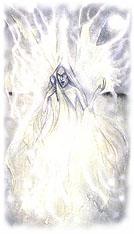|

The bean-sidhe (woman of the fairy may be an ancestral spirit appointed to forewarn members of certain ancient Irish families of their time of death. According to tradition, the banshee can only cry for five major Irish families: the O'Neills, the O'Briens, the O'Connors, the O'Gradys and the Kavanaghs. Intermarriage has since extended this select list.
Whatever her origins, the banshee chiefly appears in one of three guises: a young woman, a stately matron or a raddled old hag. These represent the triple aspects of the Celtic goddess of war and death, namely Badhbh, Macha and Mor-Rioghain.)
Although not always seen, her mourning call is heard, usually at night when someone is about to die. In 1437, King James I of Scotland was approached by an Irish seeress or banshee who foretold his murder at the instigation of the Earl of Atholl. This is an example of the banshee in human form. There are records of several human banshees or prophetesses attending the great houses of Ireland and the courts of local Irish kings. In some parts of Leinster, she is referred to as the bean chaointe (keening woman) whose wail can be so piercing that it shatters glass. In Kerry, the keen is experienced as a "low, pleasant singing"; in Tyrone as "the sound of two boards being struck together"; and on Rathlin Island as "a thin, screeching sound somewhere between the wail of a woman and the moan of an owl".
The banshee may also appear in a variety of other forms, such as that of a hooded crow, stoat, hare and weasel - animals associated in Ireland with witchcraft.
